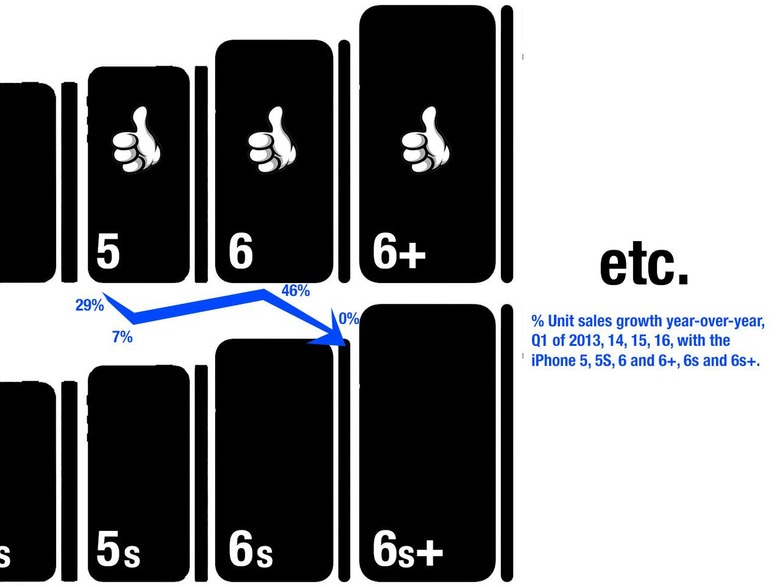Apple's iPhone Earnings "Stall" Was Inevitable
For the first time since the iPhone was introduced, growth appears to have stalled. In Apple's earnings call for their financial Q1, 2016, they've revealed that the iPhone's growth (year-over-year) sits at 0% for unit sales growth and just 1% for revenue growth. This same quarter one year ago showed 46% unit sales growth year-over-year, while the same quarter the year before that showed 7% unit sales growth year-over-year. So wait a second, you might be saying, is this the sort of thing that happens every other year?
Back in Q1 of 2013, Apple reported iPhone unit sales growth at 29% year-over-year. Back then it was a "tick" year. Every "tock" year (when an "s" model phone is released), Apple shows growth that's far smaller than every "tick" year. Imagine that!
iPhone unit sales growth (year-over-year)
• Q1 2013 29%
• Q1 2014 7%
• Q1 2015 46%
• Q1 2016 0%

The year the iPhone 5 was released, Apple had large unit sales growth in their reported unit sales for financial Q1 (reporting the holiday season of that iPhone 5 year). Unit sales growth goes down the year the "s" model is released, then unit sales growth goes back up when the iPhone 6 is released.
Unit sales growth year-over-year is larger in the years where the iPhone model is significantly changed from the year before it.
So what does Apple "need to do" to get their iPhone sales back up?
They need only release the iPhone 7.
SEE THIS: iMessage is not Android's problem
Of course moving down to a real 0% unit sales growth this quarter for iPhones is, still, significant. Apple has reached a point – this year – where it would seem that either there aren't any brand NEW iPhone users, or the number of new users is roughly equivalent to those that decided to keep their older model device or purchase an alternate brand.
So what does Apple NEED to do to return to explosive double-digit sales growth compared to this quarter? Not a whole lot. Sequential sales continue to increase by double-digits in these quarters as the year turns over regardless of year-over-year sales stalling.
• Maybe they'll release an iPhone 5se.
• Maybe they'll release an iPhone 7 (later this year) with two cameras on its back.
• Maybe they'll sell many, many more Apple Watches.
Maybe they'll continue to do what they've been moving towards doing over the past 8+ years: creating an ecosystem which entices new customers with popular hardware and keeps customers with software and services they, themselves, have tied themselves to within Apple's devices. Sound like a good plan to you?
